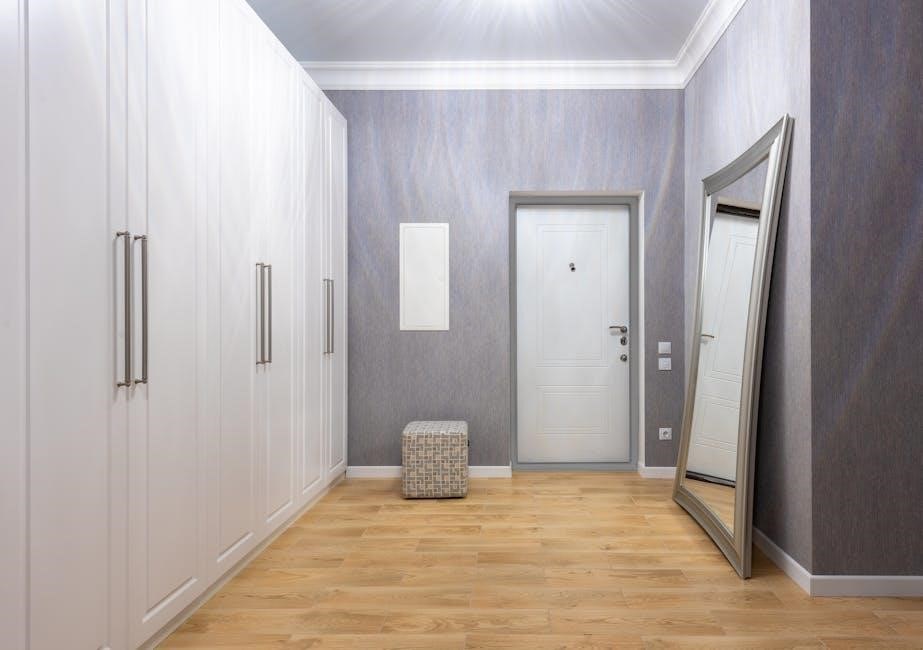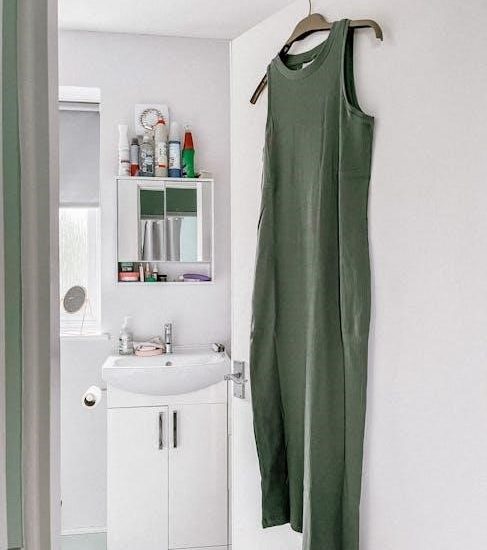Sliding closet door guides are essential components ensuring smooth operation, preventing misalignment, and reducing noise. They come in various styles, such as top-hung and bottom-mounted, to suit different door systems.
Overview of Sliding Closet Door Systems
Sliding closet door systems are designed to provide smooth, space-saving operation for closets. These systems typically include tracks, rollers, and door guides to ensure proper alignment and movement. Available in various materials like wood, metal, or glass, they offer versatility for different interior designs. The mechanisms can be top-hung, where rollers are mounted on the door and slide along an overhead track, or bottom-mounted, using floor guides. These systems are popular for their efficiency and aesthetic appeal, making them a practical choice for modern homes and commercial spaces.
Importance of Door Guides in Sliding Mechanisms
Door guides are critical for the smooth operation of sliding closet doors, ensuring proper alignment and preventing misalignment. They minimize noise and wear by keeping doors stable and evenly spaced. Guides also prevent doors from colliding or overlapping, enhancing durability and functionality. Their role is essential for maintaining the system’s efficiency and longevity, ensuring doors move effortlessly along the track without binding or sticking. Properly installed guides contribute to a seamless user experience, making them a vital component of any sliding closet door system.

Types of Sliding Closet Door Guides
Sliding closet door guides include top-hung, bottom-mounted, adjustable, and fixed options, designed to suit various door sizes and weights, ensuring smooth and stable operation.
Top-Hung vs. Bottom-Mounted Door Guides
Top-hung door guides are mounted on the door’s top edge, utilizing rollers or hinges, while bottom-mounted guides attach to the floor or track. Top-hung systems are ideal for heavier doors, reducing floor damage, and are commonly used in modern designs. Bottom-mounted guides offer stability and prevent door sway, often used in lighter setups. Both types ensure smooth operation but cater to different door weights and installation preferences, making them suitable for various closet configurations and user needs.
Adjustable vs. Fixed Door Guides
Adjustable door guides offer flexibility, allowing vertical, horizontal, and inward/outward adjustments without removing the door, ensuring smooth operation over time. Fixed guides, while less versatile, provide stability and simplicity, ideal for lighter doors. Adjustable guides are perfect for heavier doors or uneven floors, while fixed guides suit standard setups. Both options ensure proper door alignment but cater to different needs, with adjustable guides offering long-term adaptability and fixed guides delivering reliable performance in static conditions.

Installation and Alignment Tips
Accurate measuring and marking are crucial for proper installation. Use a pencil to mark hinge positions and ensure tracks are aligned. Secure guides with appropriate screws for stability.
Measuring and Marking for Proper Alignment
Measuring and marking are critical steps for installing sliding closet door guides. Start by measuring the door’s thickness to ensure proper alignment. Use a pencil to mark hinge positions on the frame, ensuring they match the door’s hardware. Align the track system carefully, checking for levelness to prevent uneven installation. Double-check all measurements before drilling to avoid errors. Proper marking ensures smooth operation and prevents misalignment issues down the line.
Tools and Techniques for Secure Installation
For a secure installation of sliding closet door guides, use a drill, level, and screwdrivers. Pre-drill holes to avoid splitting the frame and ensure the track is level. Apply wall anchors for added stability. Tighten screws gradually to maintain alignment. Use adjustable guides for precise fitting and test the door’s smooth operation. Proper technique prevents future issues like sticking or misalignment, ensuring longevity and reliability of the sliding mechanism.

Maintenance and Adjustment
Regularly clean tracks and rollers to ensure smooth door operation. Lubricate moving parts to reduce friction and noise; Adjust guides as needed to maintain proper alignment and functionality.
Regular Cleaning of Tracks and Guides
Clean the tracks and guides using a soft cloth and mild detergent. Remove dust, dirt, and grease to ensure smooth door operation. Avoid harsh chemicals. Lubricate the rollers with silicone spray. Regular cleaning prevents wear and tear, reduces noise, and keeps the doors sliding smoothly. This maintenance is essential for the longevity of your sliding closet door system. Always refer to the manufacturer’s instructions for specific cleaning recommendations.
Adjusting Door Guides for Smooth Operation
Adjust door guides to ensure proper alignment and smooth sliding. Use an Allen wrench to tighten or loosen screws. For vertical adjustment, lift the door slightly and turn the adjustment screws. Horizontal alignment can be corrected by shifting the guide left or right. Ensure the door is level and evenly spaced. Proper adjustment prevents sticking and noise. Regular checks and minor tweaks maintain optimal performance. Always refer to the manufacturer’s instructions for specific adjustment procedures.
Troubleshooting Common Issues
Identify misalignment by checking track and guide positions. Address sticking doors by cleaning tracks and lubricating rollers. Excessive noise may require tightening loose screws or replacing worn parts.
Identifying and Resolving Door Misalignment
Door misalignment occurs when sliding closet doors fail to move smoothly along their tracks. Common causes include uneven tracks, loose screws, or worn-out rollers. To resolve this, inspect the track for debris and clean it thoroughly. Check the alignment of the guide pins or rollers and adjust them if necessary. Tightening any loose screws on the track or door frame can also help. For severe misalignment, consider realigning the track or replacing damaged components to ensure proper door operation and prevent further issues.
Dealing with Excessive Noise or Sticking Doors
Excessive noise or sticking doors are common issues in sliding closet systems, often caused by dirt, dust, or lack of lubrication. Regular cleaning of tracks and guides is essential to maintain smooth operation. Apply silicone-based lubricant to moving parts to reduce friction and noise. If doors stick, check for obstructions or misalignment and adjust the guides accordingly. Worn-out rollers or bearings may need replacement to restore functionality. Addressing these issues promptly prevents further damage and ensures quiet, seamless door movement for years to come.

Choosing the Right Door Guide
Consider door size, weight, and material when selecting guides. Choose between metal or nylon options for durability and noise reduction, ensuring proper alignment and smooth functionality.
Considerations for Door Size and Weight
When selecting door guides, door size and weight are crucial. Heavier doors require sturdier guides, often metal, to handle the load without failing. Lighter doors may use nylon guides for quieter operation. Ensure guides are compatible with door thickness, typically ranging from 1 3/8 to 1 3/4 inches. Proper alignment prevents doors from binding or misaligning. Measure accurately and choose guides designed for your door’s specific dimensions and material to ensure smooth, long-lasting performance and avoid potential damage or safety hazards.
Material and Finish Options for Door Guides
Door guides are available in various materials and finishes to suit different needs. Metal guides, such as stainless steel or aluminum, offer durability and strength, ideal for heavy doors. Nylon guides provide quiet operation and are suitable for lighter doors. Finishes like brushed nickel, chrome, or white powder coat can match your interior design. Custom finishes are also available for unique aesthetics. Choose materials that align with your door’s weight and desired style to ensure functionality and visual appeal.
Sliding closet door guides are crucial for ensuring smooth, quiet, and efficient door operation. With options ranging from metal to nylon materials and various finishes, homeowners can choose guides that blend functionality with style. Proper installation, regular maintenance, and timely adjustments are key to extending their lifespan. By selecting the right guides tailored to door size and weight, users can enhance their closet’s functionality and aesthetic appeal, ensuring years of trouble-free performance. Investing in quality door guides is a small but impactful way to elevate your space.





